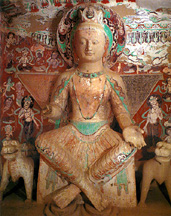
From the Mogao cave complex, Cave No. 275
Near Dunhuang, China
Northern Liang period (421-439 CE)
Clay over wood and straw core, decorated with ink and mineral pigments
This sculpted image of the Maitreya created sometime in the early fifth century is believed to be the earliest of the surviving painted sculptures in the Mogao cave complex. Maitreya is one of the most commonly found deities in the early caves, and is often depicted seated crossed-legged on a platform with his feet supported by lotus blossoms. This position sometimes referred to as "royal ease," since it is reminiscent of depictions of royalty). In Cave 275, two lions flank the throne, another reference to royalty.
As the bodhisattva destined to be born into the human realm as the next Buddha, Maitreya may be depicted in either of these manifestations. In this example he appears as a bodhisattva, wearing diaphanous robes, necklaces, armbands and a headdress (in which appears the figure of a seated Buddha, a reference to his future manifestation). Painted on the wall behind him is a host of bodhisattvas and celestial beings, dancers and musicians, indicating that this is intended to be a view of Maitreya seated in his paradise, known as Tushita ("joyful").
Iconography dictates that the statue's left hand probably once held a cintamani or wish-fulfilling jewel. While it is unfortunate that the statue has been damaged by the removal of the hand, this damage affords us an opportunity to study how clay images such as this were constructed in the fifth century. A mixture of straw and clay is affixed to a wooden framework to supply the basic shape of the image. Once this dries, successive finer coats of clay are applied to give definition and to supply the more delicate aspects, such as the facial features, hair texture and garment folds. The entire image is then coated with gesso-like layer of clay slip, and then painted with mineral pigments.